"Listen; there's a hell of a good universe next door: let's go." -e. e. cummings
Sometimes, you just need to take stock of what we know, and appreciate how far we've come. A hundred years ago, we thought the Universe consisted of the stars and nebulae in our Milky Way. We thought Newton's Law of Gravity governed it all, and that the other forces -- electromagnetism and a few weird quantum things -- were all there was.
So why not -- all in one article -- go through the entire history of the Universe, from as early as we can say anything sensible to as late as we can say anything sensible? Let's get on with it!
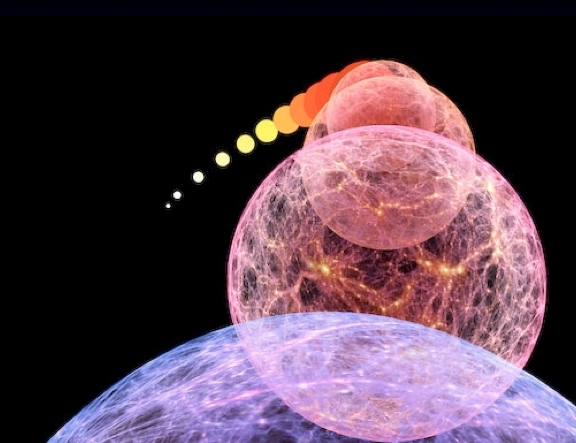
The first 10-25 seconds (or possibly even less): the Universe inflates. It expands at a rapid, exponential rate, doing a number of wonderful things. It takes whatever shape your Universe was prior to inflation...
...and stretches it flat! It takes whatever temperature or energy density you had in some minuscule region of the Universe...

...and stretches it across the whole sky, for hundreds of billions of light years! And, thanks to quantum fluctuations getting stretched as well, there are slightly overdense and underdense regions of space, embedded in our huge, flat, almost-perfectly-uniform Universe. And then...

Inflation ends! All that energy -- which was making the Universe expand exponentially -- now gets dumped into matter and radiation. Normal matter, dark matter, anti-matter, photons, neutrinos, etc., it's all there. This gives us a hot, dense Universe that's full of stuff, but that's also expanding and cooling. This point is what starts off what's known as the Big Bang. And as it gets less dense and less hot, we become able to do things!
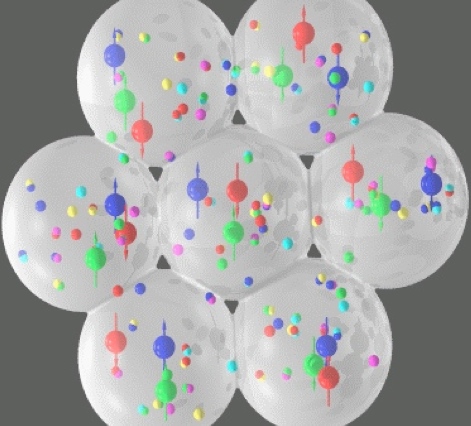
10-5 seconds: we can form stable protons and neutrons! The building blocks of atomic nuclei, the Universe actually needs to cool off for a few microseconds before it's even possible to bind quarks and gluons into protons and neutrons.
What about anti-protons and anti-neutrons, you ask? For every 10,000,000,000 anti-protons, there were 10,000,000,006 protons, for reasons we're still learning about. But as the Universe expands and cools, the anti-matter annihilates away with all the matter it can.
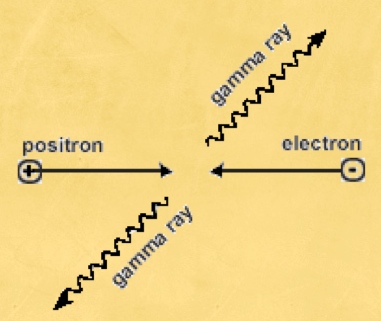
1 second: the last of the antimatter annihilates away, leaving just that tiny amount of normal matter, some dark matter, and a huge amount of photons behind! And those protons and neutrons that we've got? They'd love to fuse together, making heavy atomic nuclei, but they can't. The Universe is too hot! So you need to wait and wait. Until...
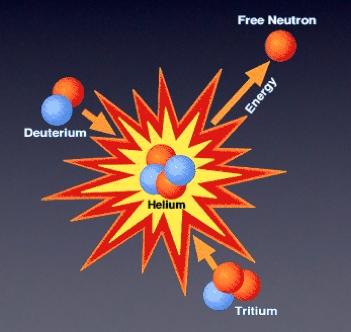
3 or 4 minutes: the Universe fuses protons and neutrons together into atomic nuclei! And although the Universe tries to fuse these nuclei into heavier and heavier elements, the Universe is only dense and hot enough to get you up to lithium, element #3.
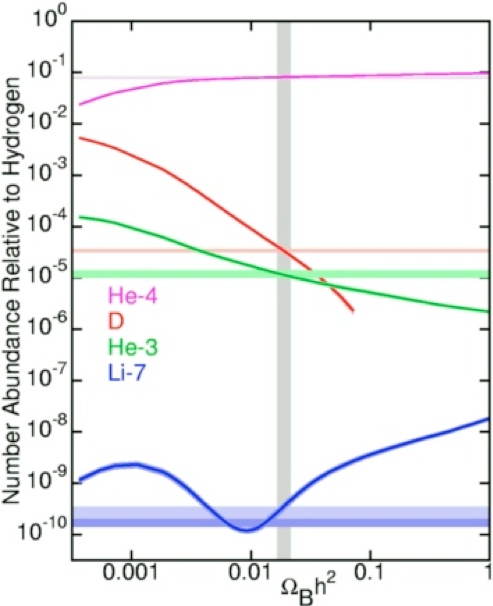
In a spectacular agreement of theory and observation, we get a Universe -- by mass -- that's about 3/4 hydrogen, 1/4 helium, and a small amount of deuterium, helium-3, and a tiny amount of lithium-7. And we'd love to just go ahead and bring the electrons on now, to make neutral atoms, but we can't. The Universe is too hot, still, for that. It isn't until...
380,000 years: we've cooled down enough to form neutral atoms. Finally, this leftover radiation is free to travel, no longer smacking into ions or electrons. And it does travel, until the present day, where it reaches our eyes, shifted well into the microwave.

The "cold" (blue, overdense) spots in this image are a temperature of about 2.7249 Kelvins, and the "hot" (red, underdense) spots are about 2.7251 Kelvins. So the Universe, all this time later, has these overdensities and underdensities left over from inflation, and the matter living there is now free to try and collapse! Which it does, until...

50-100 million years: now that the pressure from radiation has dropped to low enough levels, matter collapses! And after about 50 to 100 million years, matter collapses into dense enough regions that...

we can form the first stars! Made up almost exclusively of hydrogen and helium, the most massive of these stars live only a few hundred thousand years, and then give us what we've all been waiting for.

The first supernovae in the Universe! The heavy elements that were fused inside of this star -- including the stuff of life: Carbon, Oxygen, Nitrogen, Phosphorous, Sulphur, Iron and more -- now get blown off into the Universe, allowing the next generation of stars to form planets, complex chemistry and perhaps even the beginnings of biology.
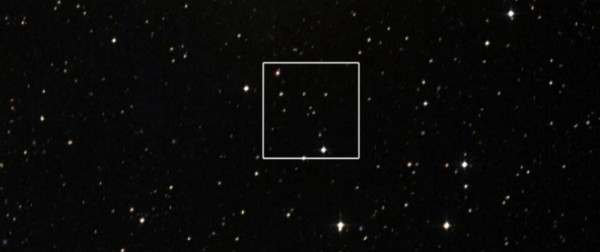
600 Million Years: these are the first objects we can directly image with a telescope today! We can find that galaxies already exist by this point, and the most distant thing we've ever seen is this gamma-ray burst, shown above, which comes from the most luminous type of explosion:
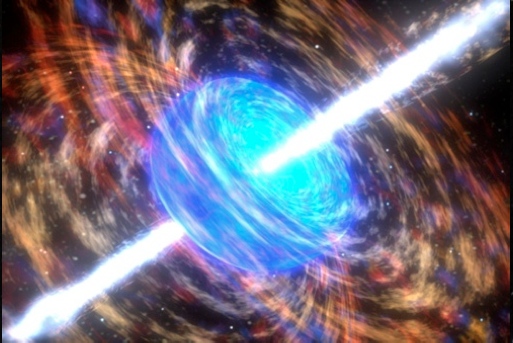
a hypernova! These first-and-second generation stars, burning through their fuel, dying and exploding, finally finish something they begun doing back when the first stars formed...

~1 Billion Years: The Universe gets reionized! All those pesky neutral atoms getting in the way of your light finally get ionized, allowing you to see the distant Universe!
"Hang on a second," you irately protest! "I thought we needed the Universe to be neutral to see light; that was the whole point of the microwave background, right?"
Take a look at this picture, and then you'll get it.

Neutral gas blocks visible light; that's why the Milky Way has those dark bands in it! But infrared (or microwave) light can still pass through neutral atoms. Visible light, on the other hand, needs your Universe to be ionized; we achieve that about a billion years into the Universe. And then, as gravity continues to do its thing...

1.8 billion years (at the latest!): galaxies fall into clusters! When they meet one another, of course, they merge and grow,

leading to the wide variety of galaxies we see today, including great spiral galaxies and giant ellipticals, as well as dwarf and irregular galaxies!
All the meanwhile, that second generation of stars we made are going through the great cosmic cycle of life, death, and rebirth.
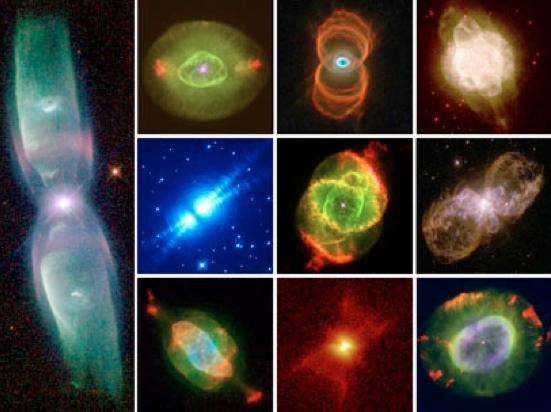
And as these stars live and die, blowing off their outer layers when they run out of fuel, their explosions trigger the collapse of gas clouds within the galaxies, causing new stars to form.

And these new stars form in a great variety of types, from hot, massive O-stars, up to a hundred times as massive as our Sun, to dim, red M-stars, burning their fuel so slowly it will take trillions of years for them to exhaust their fuel.
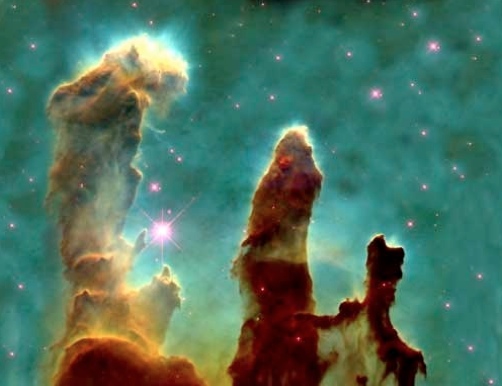
And in some forgotten corner of the Milky Way, after billions of years of this cycle, something very dear to us happened in a collapsing cloud not dissimilar from the one above.
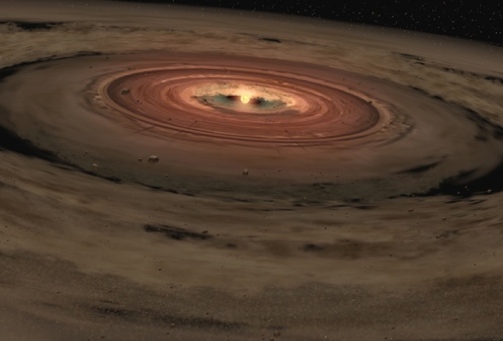
9.2 billion years: our Solar System forms! A cloud of gas and dust, enriched with the heavy elements from (at least two) generations of dead stars, collapses to form our Solar System. The star at the center ignites first, and the other planets eventually form out of our protoplanetary disk. Earth is actually one of the last planets to finish forming, because many millions of years after the other planets form...

the last two giant proto-planets that would create the Earth -- the smaller of which is about the size of Mars -- collide together! The debris flung up from that collision eventually forms into our Moon, while the majority of both bodies condenses together to form the Earth, completing, roughly, our Solar System as we know it today.

Meanwhile, just a tiny bit later, something interesting is happening to the entire Universe!

9.5 billion years: dark energy starts to defeat matter! In the cosmic battle to slow down the expansion rate, matter has been working tirelessly, under the relentless influence of its gravity, to try to halt and reverse the expansion of the Universe. But at about this time, just as a very young Earth is starting to settle into its groove, the expansion starts accelerating, thanks to the takeover of dark energy!
Meanwhile, back on Earth, some fascinating things are happening.
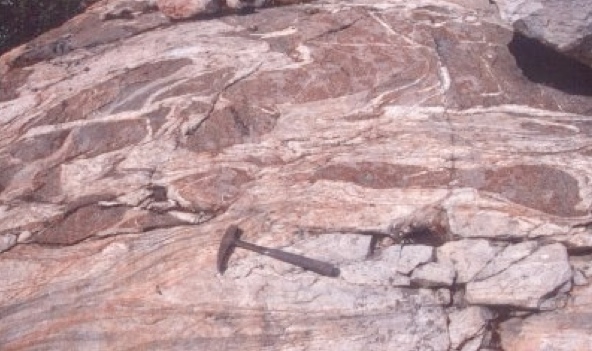
9.7 billion years: the oldest extant rocks on Earth form! Found in northwest Canada, as shown above, the oldest surviving rocks can be dated to around 4 billion years ago, shortly after the formation of the Earth itself. And it isn't long after that...

9.9 billion years: that the first evidence of life appears on Earth, too! Based on the ratios of Carbon-13 to Carbon-12, a telltale sign of life, we can determine that life has been around on Earth for at least 3.8 billion years.
And Earth might not be the only place where life thrived during this time. But our most likely candidate neighbor didn't make it the same way we did, because...
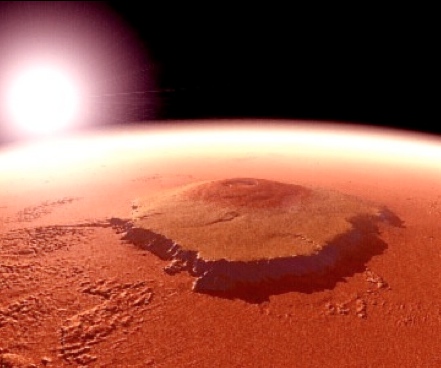
10.7 billion years: Mars dies. Our neighboring planet, once teeming with oceans, rivers, a thick atmosphere and a protective magnetic field, cools too much and loses its ability to protect itself from the solar wind. In short order, Mars' atmosphere is stripped off, leaving the pressure too low to support liquid water. And so, for the last three billion years, Mars has been much as it is now, although it may have been quite different for perhaps the first 1.5 billion years of our Solar System's history.
But back on Earth, we are having all sorts of successes. And after life has been brewing for billions of years, the two greatest evolutionary advances (in this physicist's opinion, FWIW) ever take place...

12.5 billion years: life evolves multicellularity (like red algae, above) and, slightly later, gender. Multicellularity allows specialization and differentiation like never before, and for a single organism to perform many disparate functions, but gender allows the pace of evolution to speed up like never before.
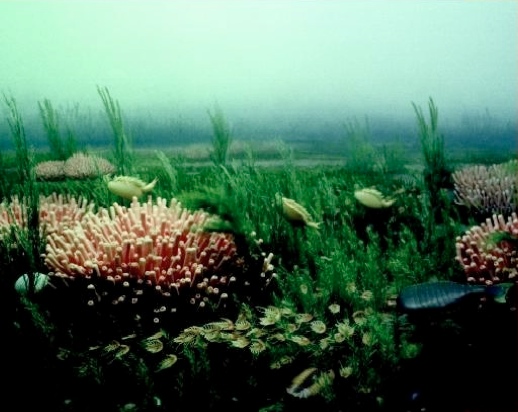
And life explodes! Plant life experiences this advance first, as do the oceans, but animals soon follow suit, and eventually take to land.

13.4 billion years: huge land animals come to dominate the top of the food chain! Reptiles held the top position for a time, eventually giving way to dinosaurs. But after a great catastrophe -- or a great opportunity, depending on your biological class -- the dinosaurs time came to an end.
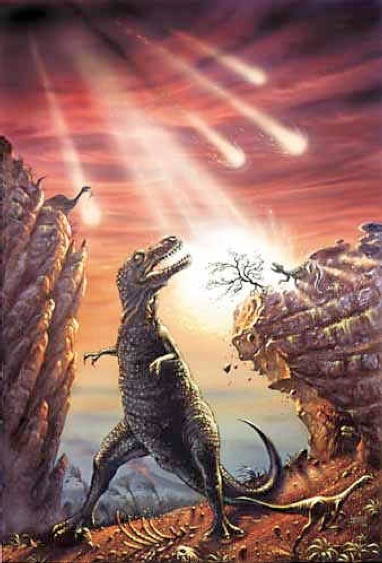
13.65 billion years: and this gave way to the rise of birds and mammals! Bringing us to the present day, where mammals now dominate the Earth.

13.7 billion years: and where humans become the first species, as far as we know, to ever willingly venture off of their home world, and land on another.
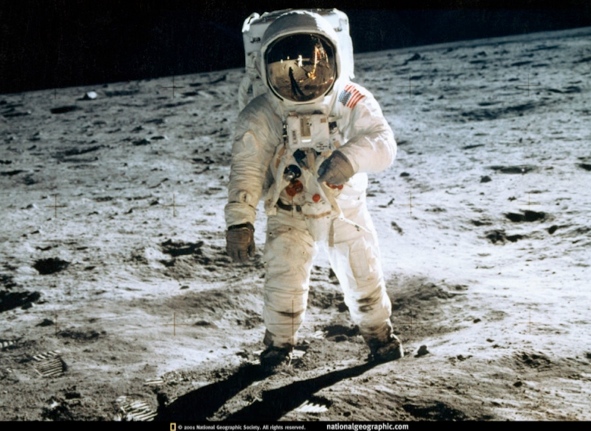
And although that brings us up until now, the Universe is still going on. In fact, if we take a look at what's happening in our corner of the Universe, we learn something remarkable. Our Sun, a consistent source of heat and light for us for the past 4.5 billion years, is getting warmer.

15 billion years: the Sun will get too hot for the Earth to house life as we know it, and will boil the oceans as it continues to burn hotter and hotter! Meanwhile, our nearest galactic neighbor, Andromeda, is coming to pay us a visit.

17 billion years: the Milky Way and Andromeda merge, creating a giant elliptical galaxy, and eventually clearing out and absorbing the entirety of the local group, including all of our satellite galaxies and globular clusters. And just at about the time the new, elliptical galaxy starts to settle down...

21 billion years: the Sun, having burned up all of its hydrogen fuel, becomes a red giant star, probably engulfing (and destroying) the Earth! (Although it may simply engulf Mercury and Venus, and blow Earth farther out in orbit.)
Meanwhile, the night sky starts to look awfully different.
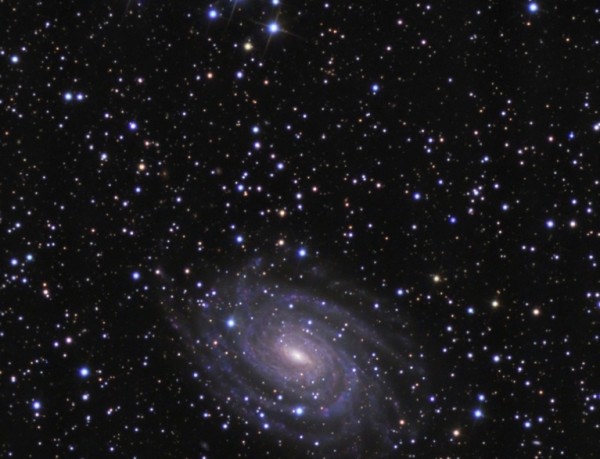
Other galaxies, so prominent and beautiful in our Universe, giving us glimpses of our own galaxy's life and history, begin to disappear!

This is what dark energy does. Even galaxies and clusters close to us, thanks to dark energy, get caught up in the expansion of the Universe and accelerate away. The galaxies that are close and prominent to us now become dim, faint, and red, while the ones even farther away disappear completely beyond the horizon.

100 billion years: the Universe has expanded so much that our local group, having merged into a giant elliptical galaxy, is the only one left in the visible Universe!
We've got a long time left of stars going through the great cosmic life-cycle, burning their fuel, exploding, triggering star formation, and burning their new fuel. But this is limited; there's only a finite amount of hydrogen and other elements to burn via nuclear fusion. The skies will eventually go completely dark, as the last of the dim, red dwarf stars (the longest-lived ones) exhaust their fuel.

1015 years: the last bit of hydrogen is burned up, and our entire Universe goes dark, being populated only by black holes, neutron stars, and degenerate dwarf stars, which eventually themselves cool, fade, and turn black.
And that's the entire Universe, from the very beginning of what we can sensibly say about it to the far distant future!
Perhaps someday I'll set this into a video, but for right now, I'll leave that to the master, who said it 31 years ago in his own incomparable style.
And that's the history of pretty much everything!
Update: Bonus question! How many images did it take to tell this story? (Hint: it's almost the 10th anniversary of his death.)

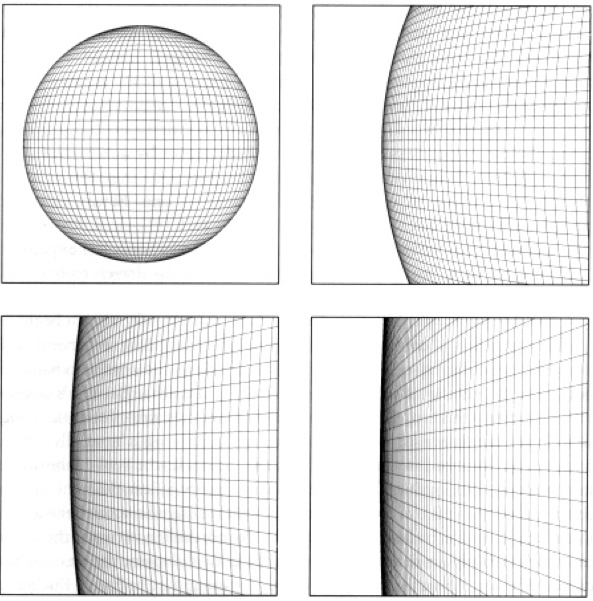
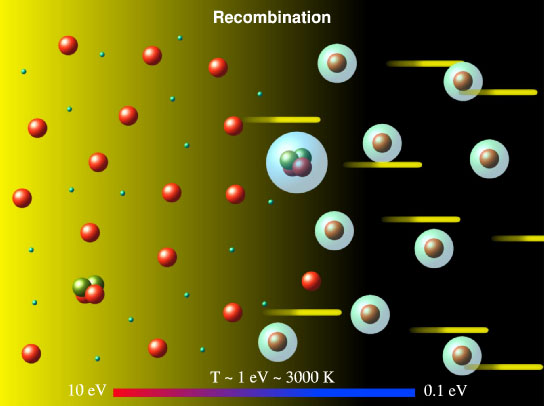
Great post, i have a question to you Ethan. How a white dwarf would look like after cooling? I mean, would be like a ball of black plasma? Solid like steel? Invisible? Or is just impossible to say?
Ohh.. Sagan. I started watching the part you recommended and I could not avoid wondering HOW did he was able to communicate the awe and meaning of science so well?. Damn...
hmm, lets tell the history of the universe in one post. okay, I'm impressed, well done Ethan. I never get tired of this wonderful story of creation, how neatly everything fits together. It's amazing how much of this story was predicted(cosmic microwave background and distribution of light elements) and verified.
Now if you could just put this into matlab? That'd be so awesome. No? I still gonna go do it? *Sigh*
*Typy typy typy*
Awesome post though!
"We are a way for the cosmos to know itself." - Should be a sticker applied to the front cover of every religious text.
I'll answer although as we learn it's not about answers but questions :) 42 images?
Bravo. Stephen said what i was thinking. Now just get it on video and submit it to TEDTalks pronto. The link I sent you should still be on ur facebook. Now start filming!
About pace of evolution.
In the april 2011 issue of Scientific American there is an article by Maryn Mckenna about development of resistence to drugs in bacterial species.
Over the years it has become clear that in general bacterial species have great capacity to share genes across species.
The phase during which such gene exchanging occurs is called 'conjugation'.
So we have that beneficial genes spread fast in bacterial species too.
At some point in time a gene exchanging method other than conjugation arose. Two haploid cells merge, in the resulting diploid cell the chromosomes are shuffled, and then an orchestrated division process re-creates two full-numbered haploid sets of chromosomes again.
At first the haploid phase was the normal phase, and the diploid phase only transitional. In some life forms the course of evolution shifted the ratio of the phases. Also in some forms the diploid phase became a multicellular life form.
Today for most diploid life forms the haploid phase (single cell phase) is completely dependent on the diploid phase.
The point of my story here is that the reason sexual reproduction is around is not necessarily faster pace of evolution.
There has always been an evolutionary arms race between pathogens and the immune systems of animals. I gather that among the reasons sexual reproduction has remained in existence is that without it animals cannot keep up with evolving pathogens.
That is, it is my understanding that the benefit of sexual reproduction is not in faster evolution, but in not falling behind too far.
With taxpayers money our illustrious scientists can give us lots of pretty pictures. But can they give us understanding of the universe? Exactly what is the dark matter and the dark energy? If these constructs of scientists cannot be detected in the laboratory, why should we believe that they actually exist? If the dark matter and the dark energy are just like the aether, then this high-priced group-think cannot explain 96% of the universe. As an amateur with a 30-year,full-time effort "working in my attic", I have made a lot more progress than this chorus of well-paid believers in understanding this enigmatic 96% of the universe. Unlike the dark matter enthusiasts, I have the results of table top experiments to back up my theoretic notions.
http://vixra.org/abs/0907.0018
Oooh, eye candy!
Let me just note and nitpick around the biology here:
- Isotope ratios can be interpreted as that a first crust forms rapidly @ ~ 10 My. If so the Mars sized impactor broke it @ ~ 50 My. Then presumably it reformed as quickly. The oldest surviving minerals found (diamonds embedded in zircons) tells of liquid water already @ ~ 50 My after the protoplanets collision.
AFAIU understand there are hints, certainly possibilities that life existed already @ 4.4 billion years ago. It could survive the remaining heavy bombardment even if extant rocks didn't, as cell can live deep in the crust and are really fast repopulators.
Same goes for Mars obviously, if life got started it could survive on energy from rock weathering until today. And it certainly had time to get started.
- Multicellularity has evolved many times over more or less independently. Even in bacteria (cyanobacteria, actinobacteria)! What differs though is that eukaryotes can take advantage because mitochondrial organelles supplies with ~ 4-6 order of magnitude more energy for protein turnover. Among other things it supports large genomes and their efficient utilization.
Mitochondria are more or less without genomes and produce mostly energy. When bacteria organize the same, some bacteria makes badass large cells, they have to clone and sustain their entire genome many times over. So they don't get the leverage we do.
And of course what makes mitochondria the "non-nuclear powerhouses" [sic!] of our cells is because the Great Oxygenation Event. Without aerobic metabolism, not so much energy.
- Noting multicellularity is a very species-centric way of looking at evolutionary speed. Measuring gene birth-death processes shows the Archean Expansion as the "true" explosion of the biosphere. (Which directly ushered in the redox/e- transfer processes that lead up to the GOE.)
It is good for evolutionary diversity, I'll give it that. And we can note from the diagram in the link that the diverse co-evolution it sustains is indeed catching up with the monocellular AE speed, it has doubled the speed from monocellular evolution. Yet another factor of two to go though.
- Ironically the reptiles that dominated before the Permian extinction let dinosaurs take over had among them the ancestors to mammals. So the tables of opportunity turns often. And as it happens it turned out well - birds _are_ dinosaurs by cladistic phylogeny as we are still those reptiles that once suppressed them.
For my money (and I'm no biologist, just a sometime student of astrobiology), the AE and the GOE & subsequent mitochondrial endosymbiosis where the defining moments of the biosphere history.
If I'm going to abstract away from an anthropocentric view of evolution I would look at evolutionary success.
Viruses beats cells for cheer numbers (with an estimated order of magnitude), the most successful selfish genes that have evolved.
Then comes bacteria/archaea, who also dominates in biomass/cycling of elements.
Eukaryotes are "the pond scum"... :-D
While I composed my "small" response to a great post, Cleon Teunissen posted a comment that partly shores up my points and vice versa.
Indeed, sexuality may have been an attempt to catch up. I have seen a description of the proverbial Amoeba, that has fallen of the popularity chart because its large size is due to the largest genome ever. Unfortunately, since it seems to have evolved an alternative to sexuality; it increases then decreases its genome size with 2-3 times between divisions. The author speculated that the mutation-and-mix-and-match-and-random-junking made up for sexual same.
Now I happen to think that our way is more _fun_ than the Amoeba way, and it would sit ill with multicellularity (enormous cells). But it shows that if you aren't a bacteria, and possibly because you _have_ a larger genome to stay in the business, you may have to run to keep standing still.
@ Peter Fred:
But those things _are_ detected in the "laboratory", except the running experiments are too large to actually fit into _our_ laboratories. They are natural experiments and results in bona fide observations.
If you had made "a lot more progress" then your peer-reviewed publications would dominate the science market. Where are those?
Ouch, a 3d longish comment! Since I have to nitpick myself:
"life existed already @ 4.4 billion years ago." More like 4.3 billion, in that picture.
"he diverse co-evolution it sustains is indeed catching up with the monocellular AE speed, it has doubled the speed from monocellular evolution." Doesn't make sense. In the later part I refer to the baseline before and after AE, see the diagram.
[I'll take my hat and leave now.]
It's good info but really, make sure you know opposite of of a electron. Its a proton not a positron.
The opposite of an electron in charge only can be a proton. The opposite of an electron in charge, mass, and all other characters is a positron.
Now for my question(s):
1) at the point where the first stars start going supernova, what is the approximate size of the universe? The reason I ask is that (obviously) stars are very small compared to the volume, of even the solar system much less and entire galaxy. Even if you had billions of billions of these things cooking off, if the universe were too big, apprpriate sized clumps would have a hard time forming.
2) I'm guessing the sun is not a 3rd generation star as I was taught 25 years ago.
3) ($64,000 question) Is dark matter a recent 'invention' of the universe, or has it always been present resisting the effects of the normal matter in the universe?
You stopped talking about evolution without mentioning the Singularity! :P
Help!
When I read this stuff I always ask to myself:
But, without us observing the Universe, there will still be a Universe?
Thanks, bye.
I have a question on the third picture, the "horizon" of the observable universe. If I'm understanding it right there is stuff (galaxies and matter) outside the observable universe. But for it to be true, the expansion of the universe must at a given time be faster than the speed of light, right? If so, how is it possible? Relativity is not valid during inflation or something?
Haha! The Lord God is AWESOME! :))
Dan,
I'm not sure that's a meaningful question, but to the extent it is, I have to ask: what counts as "us" in this context? Are humans somehow privileged, and if so, why? Or would a hypothetical sapient organism 5 billion light-years away do equally well? For that matter, is intelligence relevant? My cat shows plenty of signs of observing the universe. Brain? Or is the response to stimuli of a morning glory or amoeba sufficient?
The problem with a question like that is that it gets into time paradoxes: humans evolved from simpler organisms that came into being from nonliving matter. At some point in the scenario Ethan describes, the first living thing came into being. It needed a universe to exist in. But if the universe needed to be observed, that leaves the observer no place to form.
Ha, stumbled upon this and I was like, WOAH, THAT GUY WAS MY PHYSICS PROFESSOR! and than had a nerd-gasm.
Also, very interesting! I just imagined you (Ethan) standing in front of the lecture hall saying all this stuff. I can't believe I used to see you around campus and wonder who that weird guy wearing a kilt was. Brilliant!
This is definitely not the history of everything. Us humans know about 5% of whats really out there.
Not really qualified to comment here, so here's: Thank You- Most excellent! (not to mention witty) !
peace
At night in high summer we look for constellations on an island in the Kennebec River in Maine, even though the nearby malls and car dealerships have totally destroyed the viewing. It's hard to even see Antares at 1 a.m. The glow is too bright. It's sad to think something as simple as looking at the stars with your kids is now off-limits. But capitalism must move forward, I guess. God Bless The Starless Night.
Thank-you for the beautifully prepared presentation, Ethan.
we should, however, perhaps have reservations with respect to the certainty of the models for the more distant time-frames, both past and future.
While they reflect views favored by many in appropriate disciplines, I think maybe you would have to agree that this consensus is far from universal and evidence is rather tenuous?
You may be interested to check out my personal sub-plot to your grand saga. It is set in a more temporal field for which evidence has greater weight and examines the persistent evolutionary patterns which extend beyond biology. It is entitled "The Goldilocks Effect" and is a free download in e-book formats from the "Unusual Perspectives" website. Among other issues it suggests a plausible explanation for why the SETI operation has been, and is likely to remain, fruitless.
very nice!! I enjoyed so much in this journey.
Vicki,
Thanks for your comment.
I dot think we are privileged,we are neither better nor superior, only different.
For a cat Jupiter does not exsist. For us yes we even have used it for ours spacecrafts, for what is called gravity assist if i remember it well.So, it seems to me that without some sort of beeing like us that it is able to assemble a rocket the Universe does not exist or at least it would be a waste of energy.
Sorry, perhaps I am the one wasting my own time and energy asking myself such questions.
I am confused..
Bye.
@ ogremkv:
1) I think you are asking about the density of the universe. The universe is much larger than the observable universe (by curvature i.e. inflation), possibly and parsimoniously infinite.
2) Pop 1 = 3d gen. [Wikipedia]
3) AFAIU, in standard cosmology DM has left an imprint on CMBR.
@ Dan:
- "I refute it thus!" [/kicks stone] David Deutsch has taken Samuel Johnson's argument for reality and put it in testable form; reality is what you get when specific actions gives specific (constrained) reactions. If there isn't a real stone, your kick will pass through or deflect haphazardly, et cetera.
Thus Newton's 3d law of action-reaction in classical mechanics, or more generally interaction-observable in quantum mechanics, embodies realism and has been tested plenty.
So trees makes sound when falling in the woods, no matter what.
@ yeah:
Not so. Since standard cosmology came around we learned of the other 95 % and much on how it behaves.
@ Peter Kinnon:
Careful, with evolution one mean "biological evolution". Unless the mechanisms are the same, there isn't any faithful pattern extension. Since no systems outside biology (or our genetic algorithm software) has heredity as of yet, there is only pattern recognition in such attempt.
I see you speak of teleology and deism on your site, which are based precisely in promiscuous yet unvalidated pattern recognition.
"This is definitely not the history of everything. Us humans know about 5% of whats really out there. "
Err if we only know about 5% how do you know its about 5% if we only know about 5%?
Circular reasoning or what??
Its a testament to the dedicated people who do this research that with a little maths and some logical interpretation of the EM and few bits of the universe that touch this planet our knowledge of the universe is at the stage it is. Knowledge is like that - it accumulates and changes with time. It can only improve.
Go Ethan...
sooo.... Does this mean you could take a high intencity magneticfied compression system to maybe create a small universe? If so sould the idea of interdemetional travel mean something intresting??? What is the expantion to time ratio of size to size comparision... Or can one even be acuretly found yet due to finding a refernce point of what OUR size to time ratio would be to neiboring uneverses...Are hyper novas a possible creator of a "BIG BANG" Does strange matter have anything to do with this??? NURAN POWER SOURSES??? How small can a hyper nova be in the begining big bang to our size... and what would the growth rate be to our universe??? would we have time to use it as a power source before it was to powerful???
So here we are, the deeper we look into the distant past towards the dawn of time in any direction the larger the universe appears to be as conceptual spheres representative of both the passing of time and the increase of spatial volume continue expanding outwards with respect to our perception at roughly the cube of the distance going onwards from the point of here to infinity. A certain logic follows that if the beginning of everything surrounds us at an infinite distance such beginning apparently continues to expand into the past rather than the future because the universe of the past appears to us as infinitely larger than anything we can see of the here and now, well, at least from this particular point of view. Cool.
What I would ponder is, we think that time in 60min will be one hour.... our universe I would belive is one inside of one... so could the one one the out side be moving at a slower rate? We need to study the expansion of these ones we can see, to maybe get an idea on what ???time??? would be... perhaps to "GOD" a day is as 1,000,000 years... get what Im saying? untill the merging is complete...
You only say that because you're a mammal. Bacteria, plants, and insects would surely argue the point, if they could talk.
Well, if by 'dominant' he means 'destructive', I'm sure our particularly nasty sub-branch of hominidae wins.
Someone else mentioned it in the replies, and it has got me puzzled as well: the far-beyond-speed-of-light expansion. How did that work out? Are our constants today not what they used to be? Did the universe get a get-out-of-jail-free card? Any light on this matter (sic) would be appreciated...
I'm surprised you define the Big Bang as the end of inflation. I'm used to seeing its beginning, or an even earlier stage (by a few Planck times), called Big Bang.
No.
Sexual reproduction evolved once. It's the rule in eukaryotes.
Multicellularity evolved several times independently, as mentioned in comment 10.
Separate sexes ("gender") evolved later than sexual reproduction, and AFAIK not just once either. In many unicellular eukaryotes, any haploid cell can merge with any other haploid cell to form a diploid one which can then undergo meiosis and form four haploid cells. -- Sexes don't have to be 2 in number. There are slime molds with 23 of them, and each sex can mate with each other.
That's not what your picture shows. It shows the Carboniferous ( ~ 305 Ma old) temnospondyl Fedexia, the skull of which was less than 15 cm long.
Solid like extremely compressed steel.
Why? It sounds as if we had somehow been planned all along.
Do you know any scientists? Scientists are not well paid, except for a few that work for corporations.
What makes you think experiments are necessary for science? Observations are necessary. Experiments are just a convenient way to arrange opportunities for observations.
I thought 500, not 50? Moon-forming impact 5.1 Ga ago, 4.4 Ga old zircons with isotopic evidence of continental crust and of liquid water?
The antiparticle to the electron is the positron.
"Observation" in quantum physics just means interaction between particles -- particles being influenced by each other's existence. No people and no consciousness are required.
Einstein's speed limit holds for movement within spacetime, not for expansion of spacetime itself.
...while the Bible is pathetic.
Wrong twice over:
1) Cats can of course see Jupiter with the naked eye. (Probably even Neptune.)
2) Cats cannot help being gravitationally attracted to Jupiter, however small and negligible the effect is. Gravity cannot be blocked.
Do we really need an explanation other than the Rare Earth hypothesis?
So... you believe not only that the universe was created, but that it was created specifically for your amusement?
Who do you think you are?
Why do you think you're important?
Why do you think terms like "waste" are at all applicable?
Let me give an alternative, the OBSERVED HISTORY of EVERYTHING (i.e. limited to observed events not speculative hypotheses, vetted or not.)
FIRST EPOCH - COSMIC EPOCH
13.2 billion years, age of oldest star ever observed HE 1523-0901
13.2 billion years, age of oldest galaxy ever observed, HUDF09
13.2 billion years, age of oldest star in the Milky Way galaxy HE1523-0901
13.0 billion years, age of oldest supernova ever observed, GRB 090423
Thus the oldest observed "classical" objects in the universe whether locally in the Milky Way or in the most distant observed galaxies are all 13.2 billion years old.
SECOND EPOCH - SOLAR SYSTEM EPOCH
4.5 billion years ago, sun forms
4.5 billion years ago, Earth forms
4.28 billion years, age of oldest rock found on Earth
Earth Fossil records, various physical dating methods
. 3.8 billion years ago, single cells (prokaryotes) emerge
. 3 billion years ago, photosynthesis emerges
. 2 billion years ago, complex cells (eukaryotes)emerge
. 1 billion years ago, multicellular life emerges
. 600 million years ago, simple animals emerge
. 570 million years ago, arthropods (ancestors of insects, arachnids and crustaceans) emerge
. 550 million years ago, complex animals emerge
. 500 million years ago, fish and proto-amphibians emerge
. 475 million years ago, land plants emerge
. 400 million years ago, insects and seeds emerge
. 360 million years ago, amphibians emerge
. 300 million years ago, reptiles emerge
. 200 million years ago, mammals emerge
. 150 million years ago, birds emerge
. 130 million years ago, flowers emerge
. 65 million years ago, non-avian dinosaurs died out
. 2.5 million years ago, the genus Homo emerges
. 200,000 years ago, Homo sapiens emerge
. 25,000 years ago, Neanderthals died out
42 years ago, first man on the moon
Today, 99% of all species that have ever lived on Earth have gone extinct.
NON-OBSERVED ASSUMPTIONS of standard cosmological model (i.e. big bang theory) INCLUDE:
. - The weak cosmological principle is correct
. - the strong cosmological principle is incorrect
. - that apparent cosmological redshift is due to velocity
. - a new inflation force, never observed
. - a new dark matter, never observed
. - a new dark energy never observed
. - the baryon asymmetry of universe is understood (or a minor problem)
. - space and time are Euclidean flat
. - the cosmological event horizon is a temporal horizon at 13.7 billion years;
. -rather than a spatial horizon at 13.7 billion light years (distance)
The weak cosmological principle from wiki, "Viewed on a sufficiently large scale, the properties of the Universe are the same for all observers."
The strong cosmological principle stated by Einstein, "The general overall features of the universe are the same relative to any local observer at any cosmological epoch."
The difference is the phrase "at any cosmological epoch."
The speculation that, at "10^-5 seconds: we can form stable protons and neutrons!", is nonsense. Let me paraphrase this hypothesis, "Once upon a time, before 13.7 billion years ago plus 10^-5 seconds, there was no place in the entire universe where protons and neutrons could form." No, no, this paraphrase is too detailed. Let me paraphrase again, "Once upon a time, before 13.7 billion years ago, there was nothing, no universe. And out of that nothingness came something, the universe." This is metaphysics and philosophy. If physics speculation continues to the point where the current laws of physics break down; then don't apply them. Accept that we do not know.
Remember the big bang theory is the best theory around; but that doesn't make it correct or even approximately correct (except as a pragmatic set of procedures to do correct astronomical approximations).
Since Ethan has mixed in this blog entry the big bang theory and the theory of evolution; let me point out.
1)The theory of evolution presents itself as a useful descriptive metatheory; not as a predictive theory.
2)The big bang theory presents itself as a fundamental and predictive theory. (i.e. analogous to the standard model of elementary particles.)
Oh well, there is nothing fundamental about the big bang theory; prediction of 100 billion years seem to pretty desperately make the point.
Now the important point, scientist and laymen, that I'd like you to notice is this.
The big bang theory (as presented here) has basically two epochs of observational understanding. The 13.2 billion year old level and the 4.5 billion year level. All the intermediate stuff from formation of galaxies to formation of clusters and star formation, nucleosynthesis and even CMB do very nicely with or without a big bang theory. Yes the big bang theory is the best fit; but so is Hooke's law a very good fit. but no one portrays Hooke's law as a fundamental law of physics.
You see, every thing of importance in the big bang theory happened before the 13.2 billion year ago demarcation; beyond which we have NO OBSERVATION, ONLY ASSUMPTIONS.
So the standard cosmological model comparing itself to the standard model of elementary particles is complete hubris. As your Higgs/LHC vetting post showed standard particle physicists seriously vet WITH OBSERVATION before declaring to have observed a new particle.
The standard cosmological model is infant science compared to the theory of evolution. Look at the level of detail from the fossil record, flowers emerged 130 million years ago is a real observed milestone, observed in fossils and radiocarbon dating. That's the 15th significant species epoch (if you will) as listed on wiki. On the other hand, 13.7 billion years plus 10^-5 second now protons and neutrons can form; this is pure speculation.
To Big Bang Theorists
(A Big Bang Theory Alternative or: Donât believe everything you are told)
(To be read in conjunction with
"The Big Bang -v- The Big Doughnut Theory")
If doughnuts
Those with holes not jam
Will not fit your complex plan
Of Mighty Bang
Then I would suggest another twist
To draw within your mind just this:
A sausage roll without the sausage
Long and smooth
Itâs pastry glossy
(So elongated doughnut it becomes)
(Hopefully more acceptable to your sums)
Through which galaxies
If pulled
They out the other end
Will fall
(Perhaps reduced to cosmic dust)
by
(Banging against the pastry crust)
Now if the structure of this roll
Was of one fabric
Totally whole
Galaxies could surely roam
It's outer features
Quite at home
Those features
Curved just like a dish
In or out
Just as you wish
Would bend dark space
Without the risk
Or need of gravity
(Upon which)
(Your crap theory does in part exist)
Now
When arriving at the other end
Theyâd fall back through the middle again
(Perhaps reduced to cosmic dust)
(By banging against the pastry crust)
So to recap:
After transit through the inner husk
(Note: It is just possible that this roll)
(Might need to extend slightly)
(Perhaps a bit more pastry )
(To allow some time for the cosmic dust)
(In transit down the inner husk)
(To re-form itself into the Universe )
(As we know it)
All this mixed up cosmic dust
Emerges
Tensioned
To the crust
Expanding
As the Universe
Thus:
So
Red shift you want
Red shift you get
Bending light we could forget
For
With a sausage roll
Of that size
It's more likely something
Wrong with your eyes
Thus the Universe
And all within
Is never
Ever
Required
Truly to begin
(A Much more sensible theory)
Just continued motion from end to end
With a little time to form again
ie:
Across the top and down the middle
What more do you need to solve the riddle?
So to all BB theorists this message I send
To be read twice without any bangs:
All beginnings are also an end
Repeat together: (ALL BEGINNINGS ARE ALSO AN END)
Of a previous state that was, until then
Repeat together: (OF A PREVIOUS STATE THAT WAS, UNTIL THEN)
So true beginnings we never will have
Repeat together: (SO TRUE BEGINNINGS WE NEVER WILL HAVE)
And trying to prove it will drive us all mad!
Repeat together: (AND TRYING TO PROVE IT WILL DRIVE US ALL MAD!)
So now
Have you digested that?
There was no beginning
Just a change
Or a step
The beginning?
You imagined
Then
Could not
Forget
_
Egal Bohen
And then bin Laden was killed.
Okay, now for the non-geeks please :D
Great post. And stimulating discussion (if sometimes eccentric) after.
One thing we certainly don't know about dark matter and energy - among the myriad - is how stable they are. Any thoughts about a universe when it is a thousand+ times older than today are clearly contingent on the possible stability of these largely mysterious entities. Of course the potential emergence of other effects that are as yet undetected, or perhaps even not yet operating, would also change our guesses about the future. So while the "100 billion year" projection may be close, or may not, the 10^15 projection is off the edge of the unknown.
One question I have has almost certainly been considered deeply and evaluated: How hot was the cosmic background when it was first liberated from the last scattering surface? It's 2.7K now, but that temperature has been depressed due to expansion - what was it originally? What part of the EM spectrum would we see this as occupying?
Supplementary - is the CMB variation we see due to temperature difference at the time of recombination, or timing difference of the moment of temperature transition? Or some subtle combination?
enteresan (:
Let me as an evolutionary biologist say that this is complete and utter nonsense. One word: Tiktaalik.
How is it possible that you managed to overlook the microwave background?
And why do you keep confusing theories, hypotheses and speculations?
Longest list of assertions I've seen since I last had the dubious pleasure of experiencing a Gish gallop.
Please do explain why you think there was no beginning.
Where are their decay products? What reason do we have to think they decay?
Same thing -- recombination cannot happen above a certain temperature, and happens as soon as it can.
The theory of evolution presents itself as a useful descriptive metatheory; not as a predictive theory.
It depends on what scale of predictability you seek. Geology, for example, cannot predict whether the silicon-oxygen tetrahedrons in the quartz crystal on my porch will eventually be recombined into a tourmaline crystal the next time the crust of eastern North America slams into another crustal section and is deeply buried and turned into magma. But geology correctly predicts that some quartz will be melted and will recombine into tourmaline crystals if and when such a crustal collision occurs.
DM, what reason do we have to think anything about future beaviour of dark matter? Stable or unstable, permanent or transitory, long-term dominant or superceded... there is simply not the information to make a judgement on the longest of the timescales offered.
On my question on the CMB variation - the impression I am often given is that the CMB formed at a particular point in the history of universe with variations in temperature (due to density). But what seems more likely to me, and I wanted to check with a question, is that the time of recombination varied but the temperature at recombination effectively did not, and that the variations we see are due to that timing difference. I can't really tell whether you agree, since you seem to say that temperature and time are the same thing, which is unhelpful.
With taxpayers money our illustrious scientists can give us lots of pretty pictures. But can they give us understanding of the universe? Exactly what is the dark matter and the dark energy? If these constructs of scientists cannot be detected in the laboratory, why should we believe that they actually exist? If the dark matter and the dark energy are just like the aether, then this high-priced group-think cannot explain 96% of the universe. As an amateur with a 30-year,full-time effort "working in my attic", I have made a lot more progress than this chorus of well-paid believers in understanding this enigmatic 96% of the universe. Unlike the dark matter enthusiasts, I have the results of table top experiments to back up my theoretic notions.
thank blogs kurdele nakıs
Epic post, but where are the image credits?! Some of these I recognize from Hubble and NASA but others are new. I'd love to explore these further.
Wow, this is the most astonishing thing that I have ever seen. For the past couple of days, I have been thinking that this is exactly what I want to do in my life, but you have already done it. My goal is to expand on this beautiful piece of science.